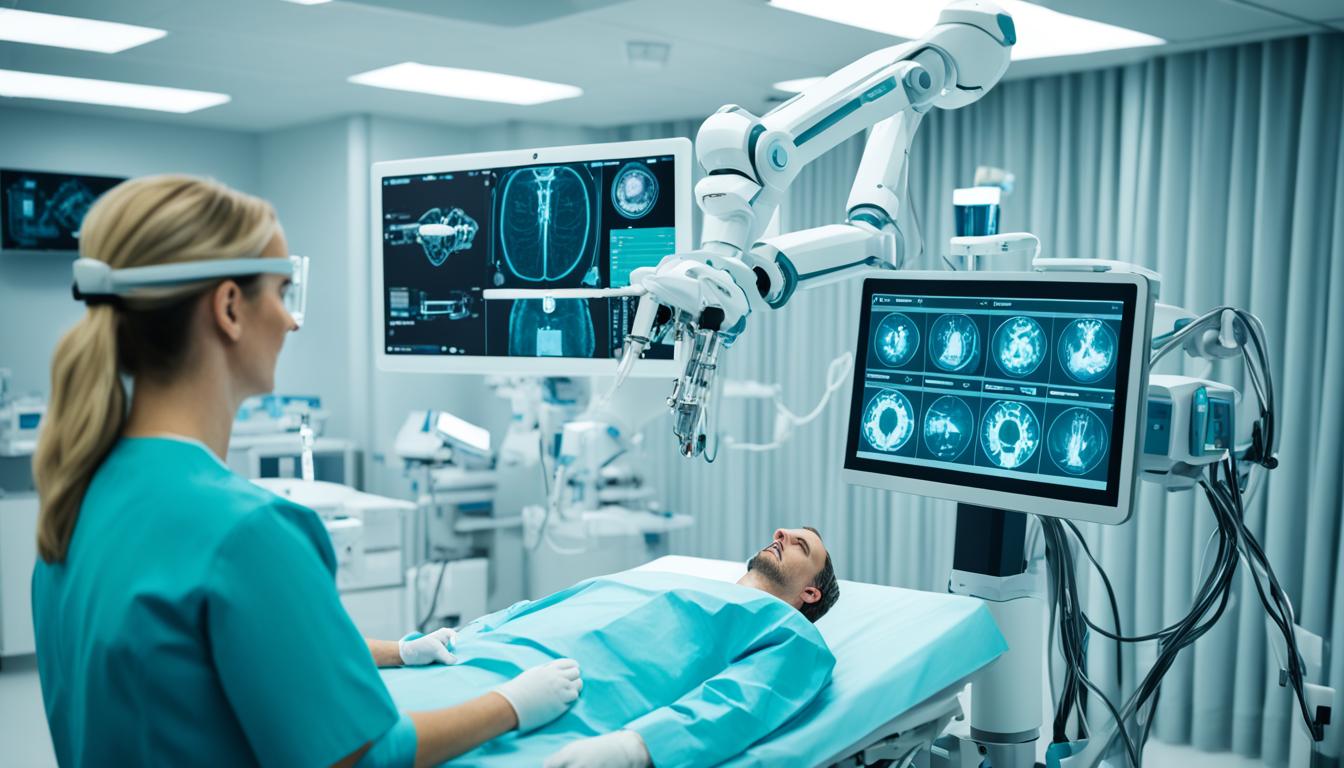AI Technology Delving into the realm of artificial intelligence technology reveals its rapid evolution and profound impact on our world. It’s not just a trend; it’s reshaping industries and redefining the future. From machine learning to robotics, AI covers a broad spectrum of technologies vital for both businesses and individuals. This exploration aims to shed light on the importance of these advancements and their potential to improve our daily lives.
Table of Contents

Key Takeaways
- Artificial intelligence technology is transforming various industries.
- Machine learning serves as a fundamental component of AI advancements.
- Natural language processing enables better human-computer interactions.
- Robotics integrated with AI technology is enhancing automation.
- AI technology is critical for data-driven decision-making in businesses.
- Understanding ethical considerations is crucial for responsible AI use.
Introduction to Artificial Intelligence Technology
Artificial intelligence technology is revolutionizing various sectors at an unprecedented pace. It’s crucial to grasp how AI applications boost efficiency and spur innovation. Companies are turning to AI to optimize processes and stay ahead in the digital era.
Machine learning stands out as a pivotal force behind these advancements. It empowers systems to autonomously learn from data, thereby enhancing their performance over time. Deep learning and cognitive computing also play crucial roles in AI’s evolution. These technologies facilitate more intricate data processing and analysis, leading to superior decision-making capabilities.
Businesses are now harnessing AI to automate mundane tasks, sift through vast datasets, and refine customer interactions. The incorporation of artificial intelligence technology has redefined workflows, setting new standards and opening up novel avenues. When implemented adeptly, firms can significantly boost productivity and foster innovation across their domains.
Understanding the Definition of AI
In my exploration of artificial intelligence definition, I’ve noticed significant variations across different contexts. This term covers a wide range of technologies aimed at mimicking human cognitive functions. These include learning, reasoning, problem-solving, and even perception.
The concept of autonomy in AI is quite fascinating. Many definitions focus on machines’ ability to operate independently, make decisions, and adapt to new information. This autonomy sets apart advanced AI systems from simpler, rule-based applications.
Types of AI include narrow AI, designed for specific tasks, and general AI, which strives to replicate human-like intelligence across various tasks. Each type has its unique purpose, defined by its capabilities and limitations.

The EU AI Act, for instance, establishes criteria based on cognitive abilities and autonomy in AI. The ongoing debate about what constitutes AI reflects technological advancements and societal shifts.
| Type of AI | Description | Autonomy Level |
|---|---|---|
| Narrow AI | Systems designed for specific tasks, such as recommendation engines or image recognition. | Low |
| General AI | Theoretical systems that can understand, learn, and apply knowledge across a wide range of tasks. | High |
| Superintelligent AI | Conceptual AI that surpasses human intelligence in virtually every field. | Very High |
Understanding these definitions and types of AI not only clarifies the field but also facilitates informed discussions about both the capabilities and implications of artificial intelligence technology.
Real-World Applications of AI Technology
The realm of AI applications has seen remarkable advancements across numerous sectors. In healthcare, AI algorithms significantly improve disease diagnosis accuracy and speed. They analyze medical images and patient data, aiding healthcare professionals in making better decisions. This integration leads to faster, more efficient patient care, marking a significant industry impact.
In finance, machine learning plays a crucial role in detecting fraud. Financial institutions employ predictive analytics to spot suspicious transaction patterns, greatly reducing risks. These systems’ efficiency showcases how AI applications are transforming traditional finance, ensuring secure transactions.
Retail businesses also leverage AI-driven analytics to improve inventory management and personalize marketing. Predictive models study customer behavior, enabling retailers to tailor their offerings to consumer needs. This synergy between AI and retail operations showcases AI’s potential in optimizing supply chains and sales strategies.

AI-powered traffic management systems are another example of AI’s impact. Cities using these technologies effectively manage traffic flow, leading to less congestion and shorter commutes. These innovations underscore the significant industry impact of AI on urban planning and infrastructure.
The use of AI across various sectors not only boosts efficiency but also hints at a bright future for integrating intelligent technologies into daily life. I foresee this trend continuing to shape the future of industries globally.
Machine Learning: The Backbone of AI
The evolution of artificial intelligence heavily relies on machine learning. This technology allows systems to sift through vast data sets and refine their performance autonomously. Understanding its mechanics deepens our grasp of its broad applications across various sectors.
Principles of Machine Learning
Machine learning is built on essential principles that dictate its operation. These include:
- Supervised Learning: This method trains algorithms on datasets with known outputs.
- Unsupervised Learning: Algorithms here work on unlabeled data, uncovering patterns and insights without pre-defined labels.
- Feature Extraction: Identifying and selecting key attributes from datasets is vital for better algorithm performance.
- Model Evaluation: This phase evaluates a model’s effectiveness, often through metrics such as accuracy and precision.
- Feedback Loop: Continuous learning involves tweaking algorithms with new data and outcomes, boosting efficiency over time.
Applications Across Various Industries
Machine learning has a wide range of applications across different sectors, transforming processes and decision-making. Here are some examples:
| Industry | Application | Use Case |
|---|---|---|
| Healthcare | Predictive Modeling | Predicting patient diagnoses based on historical data. |
| Finance | Algorithmic Trading | Using machine learning to analyze market trends and automate trades. |
| Retail | Personalized Recommendations | Improving customer experiences by recommending products based on past behavior. |
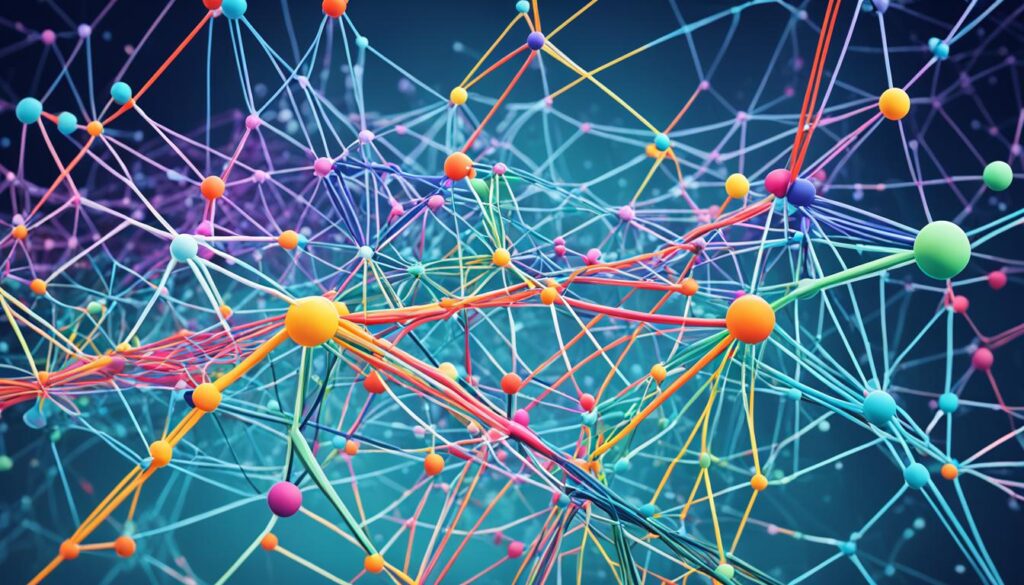
Deep Learning and Neural Networks
Deep learning is a pivotal part of machine learning, focusing on artificial neural networks to handle complex data. At its heart, neural networks are designed to mimic human thought processes. They consist of layers of artificial neurons, each with a unique function in interpreting data.
The structure of neural networks features several layers. These include:
- Input Layer: This layer takes in raw data.
- Hidden Layers: These layers process the data through weighted connections, transforming it into meaningful representations.
- Output Layer: This layer delivers the final output, often a classification or prediction based on input data.
Within these layers, each neuron uses activation functions to decide whether to pass on its signal. This process highlights deep learning’s capability to recognize and learn from complex patterns in data. It’s a key aspect of the significant AI advancements in recent years.
Deep learning applications are widespread across various sectors, including:
- Image Recognition: Platforms like Google Photos employ deep learning algorithms to categorize images effectively.
- Speech Recognition: Technologies in virtual assistants, such as Apple’s Siri, heavily depend on deep learning for better understanding and responsiveness.
Delving into the mechanics of neural networks uncovers the true essence of deep learning. As I delve deeper, the potential applications continue to grow, solidifying its role as a foundational element in the evolution of AI advancements.

| Application | Impact of Deep Learning |
|---|---|
| Image Recognition | Improved accuracy and speed in identifying objects or faces. |
| Speech Recognition | Enhanced user interaction and accessibility through voice commands. |
| Healthcare Diagnostics | Facilitated early detection of diseases through analysis of medical images. |
Natural Language Processing and Its Impact
Natural language processing (NLP) acts as a crucial link between human and machine understanding. It empowers machines to decode and generate human language, fostering more natural interactions. This technology underpins numerous applications that streamline my daily tech interactions, making them more intuitive.
AI language tools, especially chatbots, are a prime example of NLP’s application. These AI systems leverage NLP to grasp user queries, offering immediate support in customer service. Their capacity to learn from interactions boosts their accuracy over time, leading to more precise responses.

Sentiment analysis is another fascinating facet of NLP’s text analysis capabilities. It gauges the emotional undertones in text, helping organizations understand customer feelings about their offerings. This insight is crucial for businesses looking to tweak their strategies based on customer feedback.
Language translation services have transformed global dialogue. Thanks to NLP, these services now offer rapid translations, erasing language barriers for both individuals and companies. NLP’s integration into translation tools ensures the preservation of language subtleties, fostering deeper cultural understanding.
| Application | Description | Impact |
|---|---|---|
| Chatbots | AI systems that assist users via conversational interactions. | Improved customer service and engagement. |
| Sentiment Analysis | Evaluates emotional tone from text data. | Informs business strategy through customer insights. |
| Language Translation | Translates text among different languages in real-time. | Facilitates global communication. |
The role of natural language processing in AI is becoming increasingly vital. As I delve into ongoing NLP advancements, the prospects for enhanced accessibility and user-friendly technology are clear.
The Role of Automation in AI Development
In recent years, the interplay between automation and AI development has become increasingly evident. Automation empowers AI systems by efficiently managing vast data sets, which is crucial for processing and analyzing information effectively. The ability to automate repetitive tasks across various sectors leads to significant improvements in process optimization. This allows businesses to focus on more complex challenges that require human intervention.
As I observe the landscape of modern business, the integration of automation streamlines workflows and enhances productivity. This shift enables organizations to allocate resources more effectively, giving teams more time to innovate rather than getting bogged down with mundane tasks. Automation’s influence on AI development brings about transformative changes in how data is utilized, making it accessible for predictive modeling and other AI-driven analytics.
The implications for workforce dynamics are profound, as automation can lead to a reevaluation of roles within companies. While some fear job displacement, I see the potential for reskilling and upskilling, enabling employees to engage with AI tools that augment their capabilities. Organizations that embrace this new wave of technology can not only stay competitive but also foster a more skilled workforce.
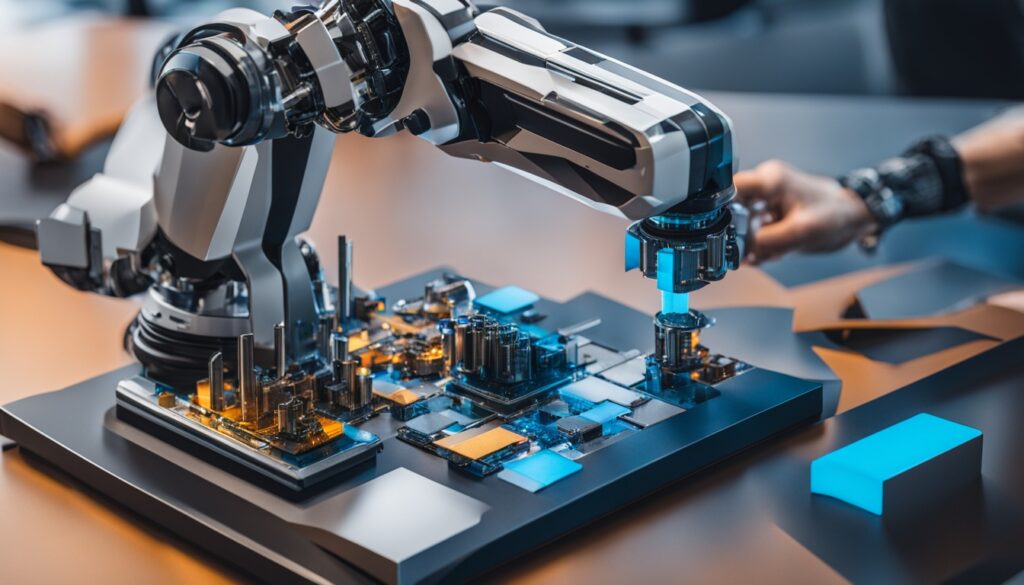
Exploring Cognitive Computing
Cognitive computing marks a major advancement in technology, aiming to mimic human thought processes. It goes beyond traditional AI by focusing on enhancing human-like understanding of complex data. This is intriguing, as cognitive systems use algorithms to learn and adapt from experiences, leading to more intuitive interactions.
In fields like healthcare, cognitive computing is crucial. For example, when diagnosing patients, these systems can analyze data as intricately as a human expert. They offer a distinct benefit by integrating various data sources, recognizing patterns, and applying insights for informed decisions. This goes beyond basic AI similarities.
| Aspect | Cognitive Computing | Traditional AI |
|---|---|---|
| Human-like Understanding | Simulates human thought processes | Follows predefined rules |
| Learning Approach | Adapts and evolves with experiences | Limited to training data |
| Data Interpretation | Handles unstructured data efficiently | Typically struggles with ambiguity |
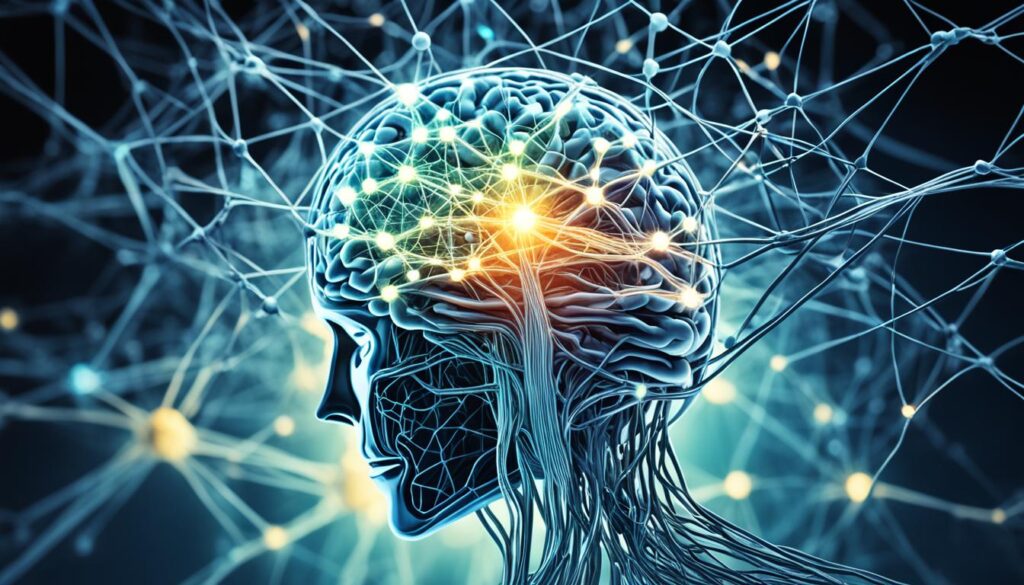
Exploring these differences highlights the unique capabilities of cognitive computing. It shows how this technology interprets and processes information, enhancing my understanding of its future applications across various sectors.
The Intersection of AI and Robotics
The fusion of AI and robotics is revolutionizing technology. This partnership elevates robotic systems, enabling them to execute complex tasks with unmatched precision and efficiency. The integration of intelligent automation has led to groundbreaking applications in manufacturing, logistics, and healthcare.
Advancements in Robotics Through AI
Recent breakthroughs highlight the transformative impact of AI on robotics. AI-powered drones now perform surveillance and delivery tasks, demonstrating their adaptability across different sectors. Robotic arms, enhanced by AI, handle intricate assembly tasks, optimizing production lines and minimizing human mistakes. These advancements not only boost efficiency but also broaden the range of tasks robots can handle in our lives.
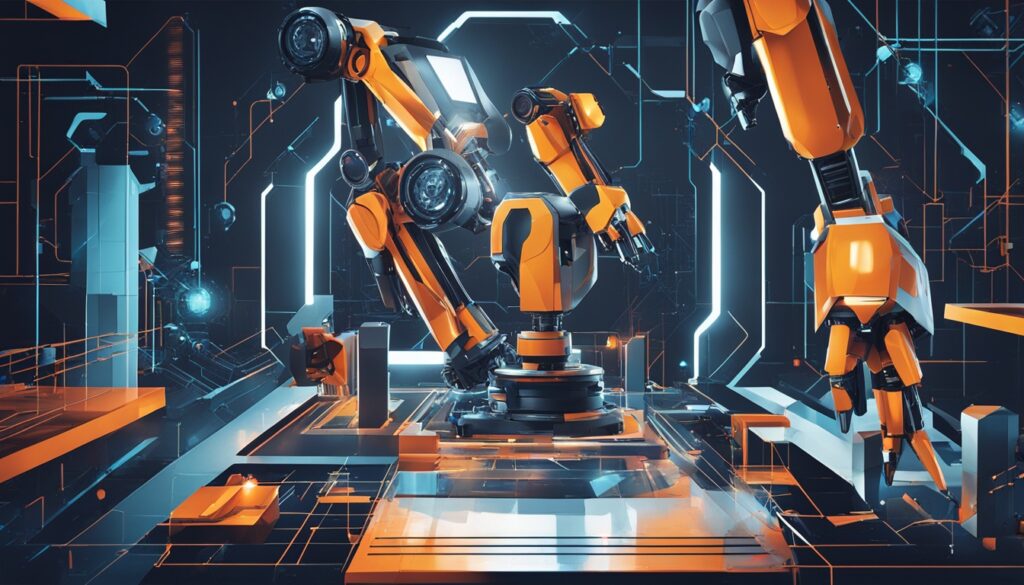
The future of robotics looks promising as intelligent automation evolves. Industries are embracing robotic systems that utilize AI, resulting in smarter, more flexible machines. These systems analyze vast data, learn from their experiences, and improve their performance. The vast potential of this technology is driving companies to invest in AI-driven robotic solutions.
| Robotic Application | AI Contribution | Industry Impact |
|---|---|---|
| Autonomous Drones | Navigation and obstacle avoidance | Logistics, Agriculture |
| Robotic Arms | Precision and adaptability in tasks | Manufacturing, Construction |
| Surgical Robots | Enhanced visualization and control | Healthcare |
| Service Robots | Personalization through interaction | Hospitality, Retail |
The synergy of AI and robotics not only propels technological progress but also opens up new career avenues. The quest for intelligent automation is set to transform how industries function, ushering in a future where robots and humans work together seamlessly.
Data Analytics: A Key Component of AI
In the world of artificial intelligence, data analytics is a cornerstone. It’s essential for the success of AI-driven data processes. By extracting insights from vast datasets, it drives innovation and supports informed decision-making. This capability allows organizations to grasp complex patterns and make choices that boost efficiency and customer satisfaction.
Leveraging Big Data for AI Solutions
Embracing big data is vital for enhancing AI capabilities. By leveraging these vast datasets, AI technology can uncover deeper insights. These insights lead to superior predictive analytics and personalized experiences across various industries. The combination of big data and AI offers numerous benefits:
- Enhanced predictive models based on real-time data.
- Improved customer targeting through advanced segmentation techniques.
- Optimization of operational workflows via data-driven strategies.
The Importance of Data Quality
Data quality is a pivotal factor in the success of AI systems. The use of data analytics highlights the need for high-quality, unbiased data to train AI models effectively. Organizations must avoid the pitfalls of poor data management, which can lead to inaccurate insights or detrimental outcomes. Numerous case studies illustrate how subpar data caused significant issues across industries.
| Data Quality Attributes | Impact on AI |
|---|---|
| Accuracy | Ensures reliable insights and predictions. |
| Completeness | Supports comprehensive analysis and decision-making. |
| Consistency | Maintains relevance across various datasets. |
| Timeliness | Enables real-time insights generation for agile responses. |

Ethical Considerations in AI Technology
The advent of artificial intelligence technology introduces profound ethical concerns that we cannot ignore. As an advocate for this field, I underscore the importance of ethical AI principles. Issues such as data privacy, algorithmic bias, and the complexities of automated decision-making require our focused attention.
Algorithmic bias is a major threat to fairness and equality. It can stem from poor data collection methods or insufficient training datasets. Frequently, I’ve seen machine learning models disproportionately impact certain groups. To mitigate this, we must prioritize responsible AI development. This includes conducting bias audits and promoting transparency.
Data privacy is another critical concern. AI systems need vast amounts of data, making it essential to safeguard individuals’ personal information. I propose the adoption of robust data governance frameworks. These frameworks should emphasize user consent and data minimization.
In conclusion, navigating the ethical terrain of AI technology necessitates continuous dialogue and proactive actions. By emphasizing ethical AI practices, we can forge systems that are not only efficient but also just and equitable.
AI Technology in Healthcare
The integration of AI in healthcare is transforming patient care. This technology offers predictive analytics, enhancing how doctors diagnose and tailor treatments. By using AI, healthcare providers see better operational efficiency and improved patient outcomes.
Transforming Patient Care with AI
AI’s transformative impact is clear in various case studies. For example, AI tools help identify health conditions faster and more accurately. Remote health monitoring systems allow continuous patient assessment, enabling proactive intervention.
Consider the following table illustrating key examples of AI applications in patient care:
| AI Application | Description | Impact on Patient Care |
|---|---|---|
| Predictive Analytics | Analyzing historical health data to forecast future health events | Enhances preventive care and reduces hospital readmission rates |
| AI-Driven Diagnostics | Using machine learning models for accurate disease identification | Improves diagnostic speed and accuracy, leading to timely treatment |
| Remote Patient Monitoring | Continuous assessment of patient health through wearables and digital tools | Supports early intervention and personalized care strategies |
| Robotic Surgery | Utilizing robotic systems for precise surgical procedures | Minimizes recovery time and enhances surgical outcomes |

Exploring the Future of AI Technology
The future of AI is brimming with potential, as we witness a rapid evolution in its landscape. AI trends are increasingly weaving their way into various sectors, heralding a new era of innovation. Generative AI, capable of generating novel content, stands out with its significant progress. This technology is transforming industries like marketing, gaming, and art, offering novel ways to engage with audiences.
Enhancing human-AI collaboration is another pivotal aspect of AI’s future. As AI systems advance, they become more skilled at augmenting human abilities. This synergy promises to elevate productivity and efficiency, especially in tasks that demand creativity and problem-solving. For example, in healthcare and finance, AI aids professionals in analyzing data, making decisions, and spotting patterns.
However, the path forward is not without its hurdles. Ethical dilemmas, such as job displacement and data privacy, accompany these advancements. It’s crucial to navigate these issues with a strategic approach, ensuring benefits are maximized while mitigating harm.

| AI Trends | Impact Areas | Potential Benefits | Challenges |
|---|---|---|---|
| Generative AI | Marketing, Arts | Content creation, Innovation | Intellectual property issues |
| Human-AI Collaboration | Healthcare, Finance | Improved efficiency, Data-driven decisions | Job displacement worries |
| Automation | Manufacturing, Logistics | Cost reduction, Streamlined processes | Skill gaps in workforce |
The journey of AI technology demands ongoing vigilance and adaptability as it evolves. By embracing the reality of change, I can delve into the latest advancements while keeping a keen eye on their societal and economic implications.
Challenges and Risks Associated with AI
In the realm of AI technology, I face numerous challenges that require attention. Privacy concerns due to data collection and the risks of AI are among the most pressing. The threat of data breaches alarms both organizations and users, underscoring the need for robust data protection.
The danger of misinformation from AI systems is another significant issue. These technologies can inadvertently produce inaccurate or misleading information, leading to ethical dilemmas. Given the increasing reliance on AI for content creation and information sharing, ensuring responsible AI usage is crucial to maintain information reliability.
Systemic bias in AI systems is a risk that demands focus. Algorithms trained on biased data can exacerbate existing inequalities, resulting in unfair outcomes across sectors like hiring and law enforcement. It’s vital to address these biases to promote equity and fairness in AI applications.

To effectively manage these challenges, regulation and oversight are key. Establishing guidelines for AI development and deployment can help mitigate risks while unlocking its transformative potential. Emphasizing responsible AI usage ensures that technology benefits humanity, upholding ethical standards.
| AI Challenge | Description | Importance of Management |
|---|---|---|
| Privacy Concerns | Issues arise from data collection and potential breaches. | Preserve user trust and comply with regulations. |
| Misinformation | AI can generate inaccurate information inadvertently. | Maintain the credibility of information sources. |
| Systemic Bias | Bias in algorithms can lead to unfair outcomes. | Ensure equity and fairness in AI applications. |
| Need for Regulation | Establishing guidelines for safe AI use. | Protect stakeholders and ensure ethical practices. |
Artificial Intelligence Technology and Its Future in Society
The AI future impact deeply influences our daily lives. As technology evolves, society faces both opportunities and challenges. It’s crucial to grasp the dual nature of these advancements to fully leverage AI’s potential while tackling its risks.

The societal benefits of AI are vast and promising. It enhances healthcare efficiency and optimizes urban planning resources. Intelligent systems are solving complex issues, boosting economic growth and enhancing life quality.
However, with each innovation, AI and societal challenges arise. Public concerns include job loss, privacy, and ethical dilemmas. Engaging with communities helps build a deeper understanding of AI, leading to informed discussions on AI policies and governance.
Every individual has a part to play in the AI future. Through education and outreach, discussing both the pros and cons encourages collective participation. This dialogue is key to responsibly and sustainably using AI. 24 IPS Blog – Blog
Conclusion
This summary of AI technology has delved into the significant advancements and uses of artificial intelligence across various fields. It has shown how AI is revolutionizing healthcare with new patient care solutions and improving data analytics for better decision-making. Each aspect of AI, like machine learning, deep learning, and natural language processing, plays a crucial role in our increasing dependence on intelligent systems.
Yet, when considering the impact of AI, we must acknowledge the ethical implications of these technologies. It’s crucial for all stakeholders to work together to create regulatory frameworks that ensure AI benefits everyone. We need to find a balance between the advantages of AI and protecting our values and rights as individuals.
My exploration highlights the immense potential of AI, but stresses the need for a careful approach to its integration. The impact of artificial intelligence on our future is clear, and it’s our responsibility to manage it wisely. We must navigate the complexities of AI with foresight and prudence.
FAQ
What is artificial intelligence technology?
Artificial intelligence technology simulates human intelligence processes using machines, especially computer systems. It includes machine learning, deep learning, natural language processing, and robotics. These technologies enable computers to perform tasks that usually require human intelligence.
How does machine learning contribute to AI advancements?
Machine learning is key to AI, allowing systems to learn from data and get better over time without explicit programming. It’s used across industries, boosting processes like predictive modeling and automation.
What are the practical applications of AI in different sectors?
AI transforms sectors like healthcare, finance, and retail. For example, it’s used for predictive analytics in healthcare, algorithmic trading in finance, and personalized recommendations in retail. This significantly improves operational efficiency.
What is deep learning, and how does it differ from regular machine learning?
Deep learning is a part of machine learning that uses neural networks with many layers to handle complex data. Unlike traditional machine learning, it can learn high-level features in large datasets without human help during feature extraction.
How does natural language processing (NLP) enhance AI interactions?
NLP lets machines understand and interpret human language. This improves user interactions with AI tools like chatbots, sentiment analysis, and language translation services. It makes technology more accessible and user-friendly.
What role does automation play in the development of AI?
Automation is vital for AI, making it possible to efficiently handle large datasets, which is crucial for training AI systems. Automating repetitive tasks streamlines operations and boosts the effectiveness of AI in various business processes.
What ethical considerations should we keep in mind regarding AI technology?
AI technology raises ethical issues like data privacy, algorithmic bias, and the challenges of automated decision-making. It’s important to create frameworks for responsible AI development to address these risks.
Can you explain the significance of data analytics in AI?
Data analytics is crucial for AI, extracting insights from data that AI algorithms can use to learn and make decisions. The combination of big data and AI is key to driving improvements and enhancing prediction accuracy across industries.
What is cognitive computing, and how does it relate to AI?
Cognitive computing involves systems that mimic human thought processes in complex situations. Unlike traditional AI, it focuses on understanding human reasoning and learning. This makes it valuable in fields needing nuanced data interpretation, such as healthcare diagnostics.
How is AI impacting the future of healthcare?
AI is transforming healthcare by improving patient care with predictive analytics, diagnostic tools, and personalized medicine. Integrating AI technologies could enhance operational efficiency and improve patient outcomes.
What are some of the challenges associated with AI technology?
AI faces challenges like privacy concerns, the risk of misinformation, and systemic bias in AI systems. Overcoming these requires ongoing regulation and oversight to ensure AI is deployed safely and fairly.

